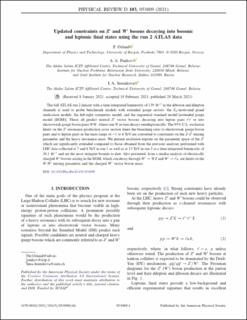| dc.contributor.author | Osland, Per | |
| dc.contributor.author | Pankov, A.A. | |
| dc.contributor.author | Serenkova, I.A. | |
| dc.date.accessioned | 2022-05-03T08:22:00Z | |
| dc.date.available | 2022-05-03T08:22:00Z | |
| dc.date.created | 2021-08-26T15:36:22Z | |
| dc.date.issued | 2021 | |
| dc.identifier.issn | 2470-0010 | |
| dc.identifier.uri | https://hdl.handle.net/11250/2993778 | |
| dc.description.abstract | The full ATLAS run 2 dataset with a time-integrated luminosity of 139 fb−1 in the diboson and dilepton channels is used to probe benchmark models with extended gauge sectors: the E6-motivated grand unification models, the left-right symmetric model, and the sequential standard model [extended gauge model (EGM)]. These all predict neutral Z′ vector bosons, decaying into lepton pairs ℓℓ or into electroweak gauge boson pairs WW, where one W in turn decays semileptonically. The 95% C.L. exclusion limits on the Z′ resonance production cross section times the branching ratio to electroweak gauge boson pairs and to lepton pairs in the mass range of ∼1 to 6 TeV are converted to constraints on the Z−Z′ mixing parameter and the heavy resonance mass. We present exclusion regions on the parameter space of the Z′ which are significantly extended compared to those obtained from the previous analyses performed with LHC data collected at 7 and 8 TeV in run 1 as well as at 13 TeV in run 2 at a time-integrated luminosity of 36.1 fb−1 and are the most stringent bounds to date. Also presented, from a similar analysis of electrically charged W′ bosons arising in the EGM, which can decay through W′→WZ and W′→ℓν, are limits on the W−W′ mixing parameter and the charged W′ vector boson mass. | en_US |
| dc.language.iso | eng | en_US |
| dc.publisher | American Physical Society | en_US |
| dc.rights | Navngivelse 4.0 Internasjonal | * |
| dc.rights.uri | http://creativecommons.org/licenses/by/4.0/deed.no | * |
| dc.title | Updated constraints on Z′ and W′ bosons decaying into bosonic and leptonic final states using the run 2 ATLAS data | en_US |
| dc.type | Journal article | en_US |
| dc.type | Peer reviewed | en_US |
| dc.description.version | publishedVersion | en_US |
| dc.source.articlenumber | 053009 | en_US |
| cristin.ispublished | true | |
| cristin.fulltext | original | |
| cristin.qualitycode | 1 | |
| dc.identifier.doi | 10.1103/PhysRevD.103.053009 | |
| dc.identifier.cristin | 1929048 | |
| dc.source.journal | Physical Review D | en_US |
| dc.identifier.citation | Physical Review D. 2021, 103 (5), 053009. | en_US |
| dc.source.volume | 103 | en_US |
| dc.source.issue | 5 | en_US |

